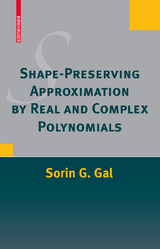Shape-Preserving Approximation by Real and Complex Polynomials
Seiten
2008
Birkhauser Boston Inc (Verlag)
978-0-8176-4702-5 (ISBN)
Birkhauser Boston Inc (Verlag)
978-0-8176-4702-5 (ISBN)
This monograph presents the first comprehensive treatment in book form of shape-preserving approximation by real or complex polynomials in one or several variables. Such approximation methods are useful in many problems that arise in science and engineering and require an optimal mathematical representation of physical reality.
In many problems arising in engineering and science one requires approxi- tion methods to reproduce physical reality as well as possible. Very schema- cally, if the input data represents a complicated discrete/continuous quantity of information, of “shape” S (S could mean, for example, that we have a “monotone/convex” collection of data), then one desires to represent it by the less-complicated output information, that “approximates well” the input data and, in addition, has the same “shape” S. This kind of approximation is called “shape-preserving approximation” and arises in computer-aided geometric design, robotics, chemistry, etc. Typically, the input data is represented by a real or complex function (of one or several variables), and the output data is chosen to be in one of the classes polynomial, spline, or rational functions. The present monograph deals in Chapters 1–4 with shape-preserving - proximation by real or complex polynomials in one or several variables. Chapter 5 is an exception and is devoted to some related important but n- polynomial andnonsplineapproximations preservingshape.Thesplinecaseis completely excluded in the present book, since on the one hand, many details concerning shape-preserving properties of splines can be found, for example, in the books of de Boor [49], Schumaker [344], Chui [69], DeVore–Lorentz [91], Kvasov [218] and in the surveys of Leviatan [229], Koci´ c–Milovanovi´ c [196], while on the other hand, we consider that shape-preserving approximation by splines deserves a complete study in a separate book.
In many problems arising in engineering and science one requires approxi- tion methods to reproduce physical reality as well as possible. Very schema- cally, if the input data represents a complicated discrete/continuous quantity of information, of “shape” S (S could mean, for example, that we have a “monotone/convex” collection of data), then one desires to represent it by the less-complicated output information, that “approximates well” the input data and, in addition, has the same “shape” S. This kind of approximation is called “shape-preserving approximation” and arises in computer-aided geometric design, robotics, chemistry, etc. Typically, the input data is represented by a real or complex function (of one or several variables), and the output data is chosen to be in one of the classes polynomial, spline, or rational functions. The present monograph deals in Chapters 1–4 with shape-preserving - proximation by real or complex polynomials in one or several variables. Chapter 5 is an exception and is devoted to some related important but n- polynomial andnonsplineapproximations preservingshape.Thesplinecaseis completely excluded in the present book, since on the one hand, many details concerning shape-preserving properties of splines can be found, for example, in the books of de Boor [49], Schumaker [344], Chui [69], DeVore–Lorentz [91], Kvasov [218] and in the surveys of Leviatan [229], Koci´ c–Milovanovi´ c [196], while on the other hand, we consider that shape-preserving approximation by splines deserves a complete study in a separate book.
Shape-Preserving Approximation By Real Univariate Polynomials.- Shape-Preserving Approximation by Real Multivariate Polynomials.- Shape-Preserving Approximation by Complex Univariate Polynomials.- Shape-Preserving Approximation by Complex Multivariate Polynomials.- Appendix : Some Related Topics.
| Mitarbeit |
Anpassung von: George A. Anastassiou |
|---|---|
| Zusatzinfo | XIII, 352 p. |
| Verlagsort | Secaucus |
| Sprache | englisch |
| Maße | 155 x 235 mm |
| Themenwelt | Mathematik / Informatik ► Mathematik ► Algebra |
| ISBN-10 | 0-8176-4702-3 / 0817647023 |
| ISBN-13 | 978-0-8176-4702-5 / 9780817647025 |
| Zustand | Neuware |
| Haben Sie eine Frage zum Produkt? |
Mehr entdecken
aus dem Bereich
aus dem Bereich
Buch | Softcover (2022)
Springer Spektrum (Verlag)
39,99 €




